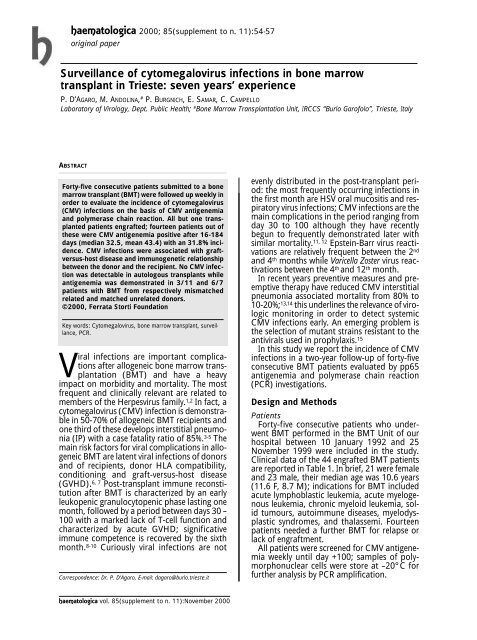Journal of Hematology - Supplements - Haematologica
Journal of Hematology - Supplements - Haematologica
Journal of Hematology - Supplements - Haematologica
You also want an ePaper? Increase the reach of your titles
YUMPU automatically turns print PDFs into web optimized ePapers that Google loves.
haematologica 2000; 85(supplement to n. 11):54-57<br />
original paper<br />
Surveillance <strong>of</strong> cytomegalovirus infections in bone marrow<br />
transplant in Trieste: seven years’ experience<br />
P. D’AGARO, M. ANDOLINA, # P. BURGNICH, E. SAMAR, C. CAMPELLO<br />
Laboratory <strong>of</strong> Virology, Dept. Public Health; # Bone Marrow Transplantation Unit, IRCCS “Burlo Gar<strong>of</strong>olo”, Trieste, Italy<br />
ABSTRACT<br />
Forty-five consecutive patients submitted to a bone<br />
marrow transplant (BMT) were followed up weekly in<br />
order to evaluate the incidence <strong>of</strong> cytomegalovirus<br />
(CMV) infections on the basis <strong>of</strong> CMV antigenemia<br />
and polymerase chain reaction. All but one transplanted<br />
patients engrafted; fourteen patients out <strong>of</strong><br />
these were CMV antigenemia positive after 16-184<br />
days (median 32.5, mean 43.4) with an 31.8% incidence.<br />
CMV infections were associated with graftversus-host<br />
disease and immunogenetic relationship<br />
between the donor and the recipient. No CMV infection<br />
was detectable in autologous transplants while<br />
antigenemia was demonstrated in 3/11 and 6/7<br />
patients with BMT from respectively mismatched<br />
related and matched unrelated donors.<br />
©2000, Ferrata Storti Foundation<br />
Key words: Cytomegalovirus, bone marrow transplant, surveillance,<br />
PCR.<br />
Viral infections are important complications<br />
after allogeneic bone marrow transplantation<br />
(BMT) and have a heavy<br />
impact on morbidity and mortality. The most<br />
frequent and clinically relevant are related to<br />
members <strong>of</strong> the Herpesvirus family. 1,2 In fact, a<br />
cytomegalovirus (CMV) infection is demonstrable<br />
in 50-70% <strong>of</strong> allogeneic BMT recipients and<br />
one third <strong>of</strong> these develops interstitial pneumonia<br />
(IP) with a case fatality ratio <strong>of</strong> 85%. 3-5 The<br />
main risk factors for viral complications in allogeneic<br />
BMT are latent viral infections <strong>of</strong> donors<br />
and <strong>of</strong> recipients, donor HLA compatibility,<br />
conditioning and graft-versus-host disease<br />
(GVHD). 6, 7 Post-transplant immune reconstitution<br />
after BMT is characterized by an early<br />
leukopenic granulocytopenic phase lasting one<br />
month, followed by a period between days 30 –<br />
100 with a marked lack <strong>of</strong> T-cell function and<br />
characterized by acute GVHD; significative<br />
immune competence is recovered by the sixth<br />
month. 8-10 Curiously viral infections are not<br />
Correspondence: Dr. P. D’Agaro, E-mail: dagaro@burlo.trieste.it<br />
evenly distributed in the post-transplant period:<br />
the most frequently occurring infections in<br />
the first month are HSV oral mucositis and respiratory<br />
virus infections; CMV infections are the<br />
main complications in the period ranging from<br />
day 30 to 100 although they have recently<br />
begun to frequently demonstrated later with<br />
similar mortality. 11, 12 Epstein-Barr virus reactivations<br />
are relatively frequent between the 2 nd<br />
and 4 th months while Varicella Zoster virus reactivations<br />
between the 4 th and 12 th month.<br />
In recent years preventive measures and preemptive<br />
therapy have reduced CMV interstitial<br />
pneumonia associated mortality from 80% to<br />
10-20%; 13,14 this underlines the relevance <strong>of</strong> virologic<br />
monitoring in order to detect systemic<br />
CMV infections early. An emerging problem is<br />
the selection <strong>of</strong> mutant strains resistant to the<br />
antivirals used in prophylaxis. 15<br />
In this study we report the incidence <strong>of</strong> CMV<br />
infections in a two-year follow-up <strong>of</strong> forty-five<br />
consecutive BMT patients evaluated by pp65<br />
antigenemia and polymerase chain reaction<br />
(PCR) investigations.<br />
Design and Methods<br />
Patients<br />
Forty-five consecutive patients who underwent<br />
BMT performed in the BMT Unit <strong>of</strong> our<br />
hospital between 10 January 1992 and 25<br />
November 1999 were included in the study.<br />
Clinical data <strong>of</strong> the 44 engrafted BMT patients<br />
are reported in Table 1. In brief, 21 were female<br />
and 23 male, their median age was 10.6 years<br />
(11.6 F, 8.7 M); indications for BMT included<br />
acute lymphoblastic leukemia, acute myelogenous<br />
leukemia, chronic myeloid leukemia, solid<br />
tumours, autoimmune diseases, myelodysplastic<br />
syndromes, and thalassemi. Fourteen<br />
patients needed a further BMT for relapse or<br />
lack <strong>of</strong> engraftment.<br />
All patients were screened for CMV antigenemia<br />
weekly until day +100; samples <strong>of</strong> polymorphonuclear<br />
cells were store at –20°C for<br />
further analysis by PCR amplification.<br />
haematologica vol. 85(supplement to n. 11):November 2000

















